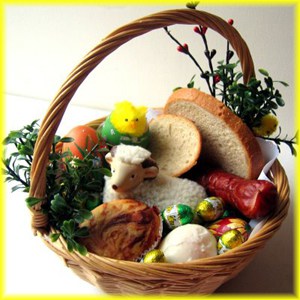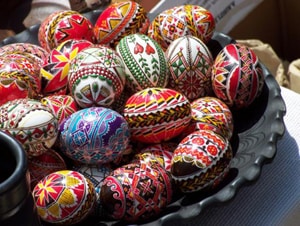

http://www.dyngusdaybuffalo.com/moreaboutdyngusday/polisheasterbaskets.html
Polish Easter Eggs – Pisanki
Eggs are a symbol of spring and rebirth all around the world, and they have also become the most enduring symbol of Easter and the Resurrection.
In Poland, Easter egg-making has developed into a true art form and there are as many methods of making them as there are traditions and rituals associated with them. Easter eggs are called pisanki in Polish, which comes from the word pisac, which means to write. Designs are drawn or words are written on a hardboiled egg with a wax stylus, then placed in a dye. When the wax is scraped off, a white pattern is revealed on the colored egg.

Altough pisanka has come to mean Easter egg in Polish, it represents only one of the methods used to decorate eggs in Poland.
Here are some of the most popular types of Easter eggs in Poland:
Pisanki – eggs with wax patterns „written” or drawn on them, then dyed
Kraszanki – solid-color eggs, dyed with plant materials such as beets, onion skins, and leaves
Malowanki – hand-painted eggs
Drapanki – solid-color eggs with a design scratched onto the surface
Wyklejanki – eggs decorated with colored yarn
Nalepianki – eggs decorated with paper cut-outs or straw
Sometimes, hollow eggs are used instead of hardboiled. The eggs can then be displayed all year long, ensuring good health and prosperity. The solid-color eggs were used for consumption; the decorated and hollow eggs would be saved from year to year. Once blessed in church on Holy Saturday, eggs were never thrown out, nor were the eggshells. Instead they would be buried in the garden or field as crops were sown, bringing good fortune and ensuring a good harvest. The water used in cooking Easter eggs was also saved and used to water fruit trees and to wash beehives. This was believed to result in sweet-tasting fruit and delicious golden honey.
On Easter Sunday, before Swiecone, the traditional Polish Easter Brunch, a blessed Easter egg is shared by the family, as Easter wishes are exchanged. Pets and livestock were given a blessed Easter egg to eat as well.
Source: POLISH WOMEN’S ALLIANCE:
http://www.pwaa.org/Polish_Traditions.htm#easter
